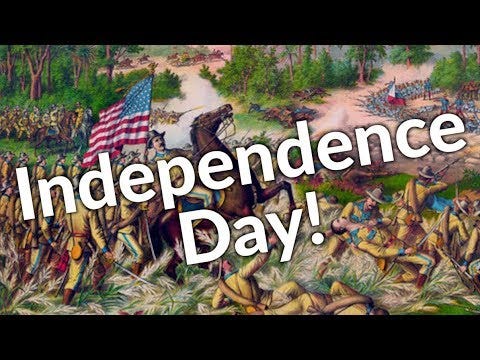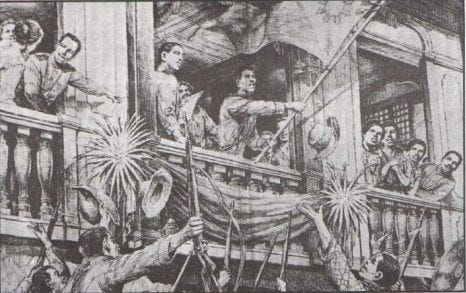From Revolution to Liberation: Unraveling the Epic Journey of Philippine Independence
Filipino American historian, content creator, and renowned culture bearer Kirby Pábalan-Táyag Aráullo writes about the interesting history of Philippine Independence Day.
As Filipinos worldwide celebrate June 12 as Independence Day, reflecting upon the multifaceted history that has shaped the nation's quest for freedom is essential. Beyond the iconic proclamation of independence by Emilio Aguinaldo on June 12, 1898, lies a turbulent narrative of struggle, resilience, and ongoing challenges. This article will delve into the intricate journey of the Philippines, exploring the legacy of colonization, the arduous path to self-governance, and the nuances surrounding the concept of true independence.
From Spanish Colonialism to American Imperialism:
June 12, 1898, holds immense significance as the day Emilio Aguinaldo, the "President" of the Revolutionary government, declared Philippine independence from Spain. This historical event, etched in the memories of Filipinos, took place within the walls of the Aguinaldo mansion in Kawit, Cavite. Aguinaldo's proclamation symbolized national pride and was once immortalized on the 5 Peso bill.
However, the jubilation was short-lived, as the First Philippine Republic faced a bitter and brutal conflict against the United States from 1899 to 1903. Some argue that this struggle persisted until 1913. While initially supportive of Philippine independence, the United States soon struck a deal with Spain, acquiring the islands. The replacement of Spain with the U.S. as the new colonial power marked the beginning of what many consider U.S. imperialism. The American administration disregarded Filipino sovereignty and the right to self-determination, effectively sidelining the Philippine Proclamation of Independence.
The Commonwealth Period and World War II:
Inaugurated on November 15, 1935, the Commonwealth of the Philippines represented a step towards self-government, although still under U.S. colonial rule. This arrangement, akin to the status of present-day Puerto Rico, provided a certain degree of autonomy while denying Filipino citizens full U.S. citizenship.
American rule persisted until the outbreak of World War II. On October 14, 1943, the 2nd Philippine Republic was established. On paper, this Republic aimed to fulfill the promise of an independent Philippines free from Western imperialism. However, it became a puppet state heavily influenced by Japanese imperialism. The 2nd Republic's existence was short-lived, ending on August 17, 1945.
The Birth of the 3rd Philippine Republic:
Immediately after World War II, on July 4, 1946, the United States finally "granted" the Philippines its "independence." Coincidentally, this date aligned with the birthdate of Uncle Sam himself, July 4. Thus, the 3rd Philippine Republic emerged, symbolizing the country's supposedly independent status.

President Diosdado Macapagal & Today’s Celebrations:
In 1962, President Diosdado Macapagal declared June 12 as a memorable public holiday throughout the Philippines. By doing so, he distanced himself and the country from the shadows of the United States. Macapagal's vision was for the Independence Day celebration to reflect the day Filipinos broke free and asserted their freedom rather than commemorating the day granted by colonizers. He eloquently stated that a nation is born free when its people, united through struggle and sacrifice, assert their natural right to liberty.
The Cry of Pugad Lawin and Revolutionary Traditions:
While June 12 is widely recognized as the official Independence Day, a contentious debate arises about whether it truly marks the origin of the Philippines' revolutionary struggle for freedom. Casting our gaze back to August 1896, a watershed moment known as the Cry of Pugad Lawin, or the Cry of Balintawak, emerges as the historical catalyst that ignited the flames of the Philippine Revolution. Comparable to the renowned Grito de Dolores in Mexico and Brazil's Cry of Ipiranga, this profound event resonates as an impassioned declaration of an indomitable people's unwavering resolve to wage a courageous battle for their cherished independence
The Ongoing Struggle for Genuine Independence:
Today, the world acknowledges the Philippines as an independent nation-state with sovereignty vested in its diverse populace. However, many experts and activists argue that genuine independence remains elusive. The relationship between the Philippines and the United States has been scrutinized as a form of "neo-colonialism," an updated version of imperialism where the Philippines continues to be subservient to the whims of its former colonizer.
As the Filipino community gathers in jubilation to commemorate Independence Day, it becomes paramount to engage in introspection, weaving together the intricate threads of history that have intricately shaped the nation. From the audacious acts of defiance witnessed at Pugad Lawin to the arduous battles fought against Spanish and American dominion, the relentless pursuit of genuine independence remains an enduring quest. The Philippines stands resolute, an embodiment of its people's unwavering resilience and indomitable spirit, its collective memory is interwoven with a vision of freedom and an unyielding determination to carve its own destiny. —Kirby Araullo
About the Author:
Kirby is a Dátû and Lakan by blood, and an Activist at heart. He is a direct descendant of the last Paramount Kings of Luzon (of both Lakandúlâ of Tondo and Rája Matandá of Maynílâ), and of the anti-colonial revolutionary Katipuneros and World War II Guerilyeras who fought for the liberation of the Philippines from colonialism. His upbringing exposed him to the contradicting worlds of traditional politics and grassroots activism. He is a historian, author and culture bearer and is best known for his popular YouTube channel about Philippine History.
Learn more about Kirby and his work at kirbyaraullo.com Watch his YouTube channel here.






